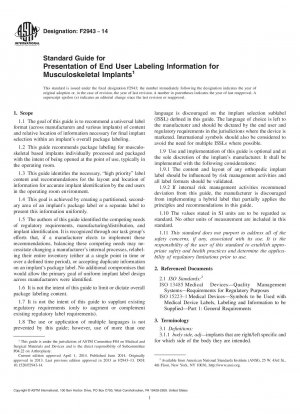ASTM F2943-14
Standard Guide for Presentation of End User Labeling Information for Musculoskeletal Implants
- Standard No.
- ASTM F2943-14
- Release Date
- 2014
- Published By
- American Society for Testing and Materials (ASTM)
- Status
- Replace By
- ASTM F2943-14(2019)
- Latest
- ASTM F2943-14(2019)
- Scope
4.1 Implantable medical device labeling often results in a variety of label formats and information prioritization. This variability can be seen not only across different manufacturers but also across different implant types.3 At present label design and layout is developed by a given manufacturer and represents balancing internal needs (such as manufacturing, distribution, and marketing), regulatory requirements within various markets, and end user needs (as identified by individual manufacturers performing “voice of the consumer” feedback on their label designs).
4.2 At no fault to any given manufacturer, this process, along with the manner in which label information competes for available “real estate” on a package, often leads to variable prioritization of label information and highly variable label designs. The impact of this variability on patient care is not well documented within the published literature. An article from AAOS Now in 2009 described potential issues around label variability and gave anecdotal evidence of its impact.3
4.3 No published literature demonstrating a clear and conclusive impact on patient safety resulting from implant label variability was identified. Despite this lack of evidence, anecdotal observations and input from various involved individuals and organizations (surgeons, operating room nurses, hospital administrators, product representatives, and manufacturers) suggests a potential, although unproven, benefit for an increased standardization of implant labeling.
4.4 The authors of this guide believe it is important to highlight that no universally accepted method for validation of a label’s effectiveness exists. Current validation methods consist of varying methods of customer feedback on an existing label design using formal customer questionnaires, informal customer feedback through individual polling, and internal manufacturer-driven studies. The label recommendations presented within this guide have not been validated as more or less effective than other existing implant labels currently in use.
4.5 These recommendations have been developed through the collaboration of an ASTM-sponsored task group with representation from large and small orthopedic implant manufacturers, orthopedic surgeons (specifically the Biomedical Engineering Committee from the American Academy of Orthopedic Surgeons), healthcare facility administrators, operating room nurses, the U.S. Food and Drug Administration (FDA), and the Canadian Healthcare System. The task group utilized “voice of consumer” feedback from previous manufacturer label initiatives combined with input from various end users on the task group. This process did not identify any given implant label format as being more or less effective but only attempts to prioritize information and recommend a universal format for this information. A manufacturer may determine that an alternative format may be more effective for its internal processes and elect not to follow these recommendations.
1.1 The goal of this guide is to recommend a universal label format (across manufacturers and various implants) of content and relative location of information necessary for final implant selection within an implant’s overall package labeling.
1.2 This guide recommends package labeling for musculoskeletal based implants......
ASTM F2943-14 Referenced Document
ASTM F2943-14 history
- 2019 ASTM F2943-14(2019) Standard Guide for Presentation of End User Labeling Information for Musculoskeletal Implants
- 2014 ASTM F2943-14 Standard Guide for Presentation of End User Labeling Information for Musculoskeletal Implants
- 2013 ASTM F2943-13 Standard Guide for Presentation of End User Labeling Information for Orthopedic Implants Used in Joint Arthroplasty

Copyright ©2024 All Rights Reserved